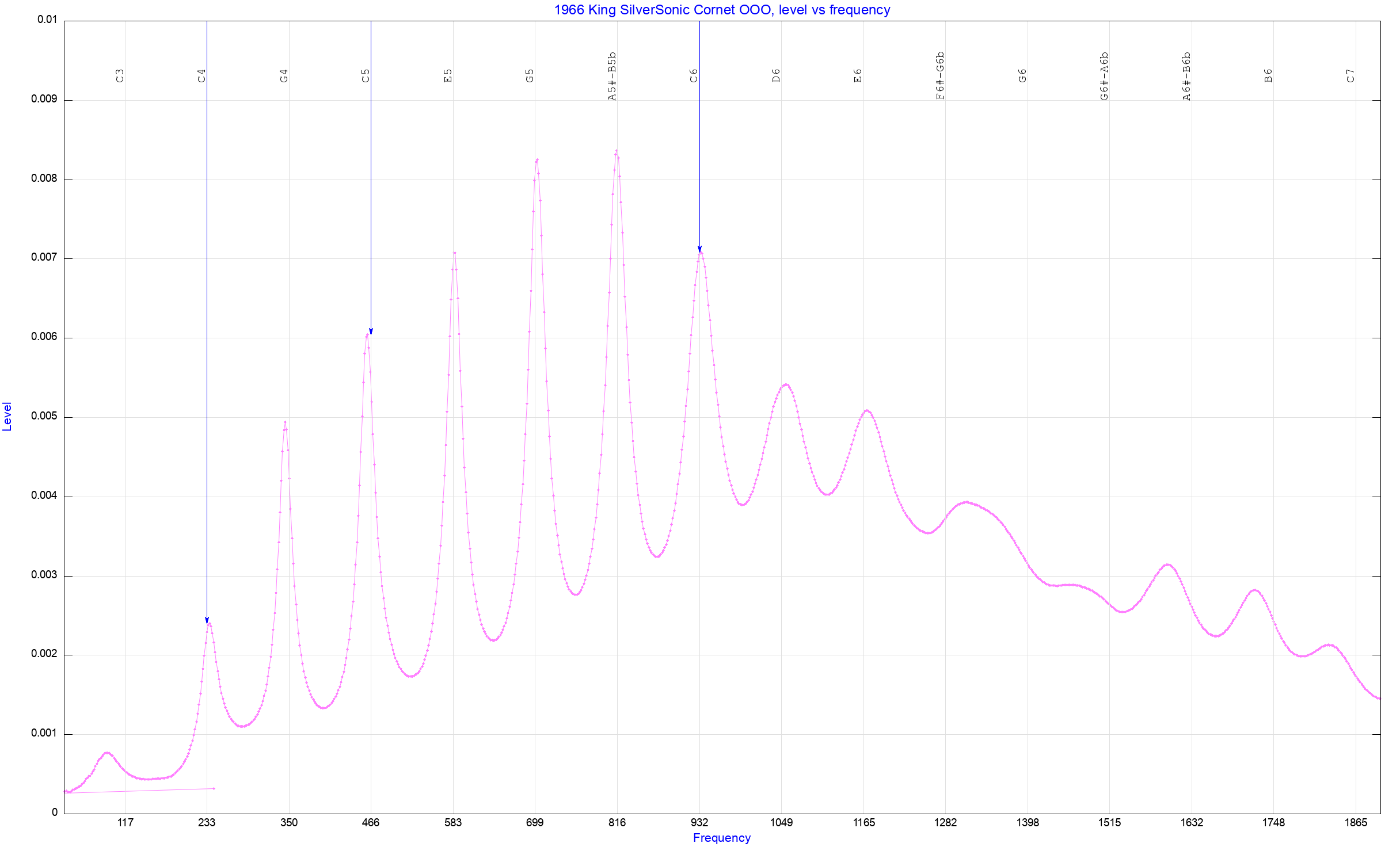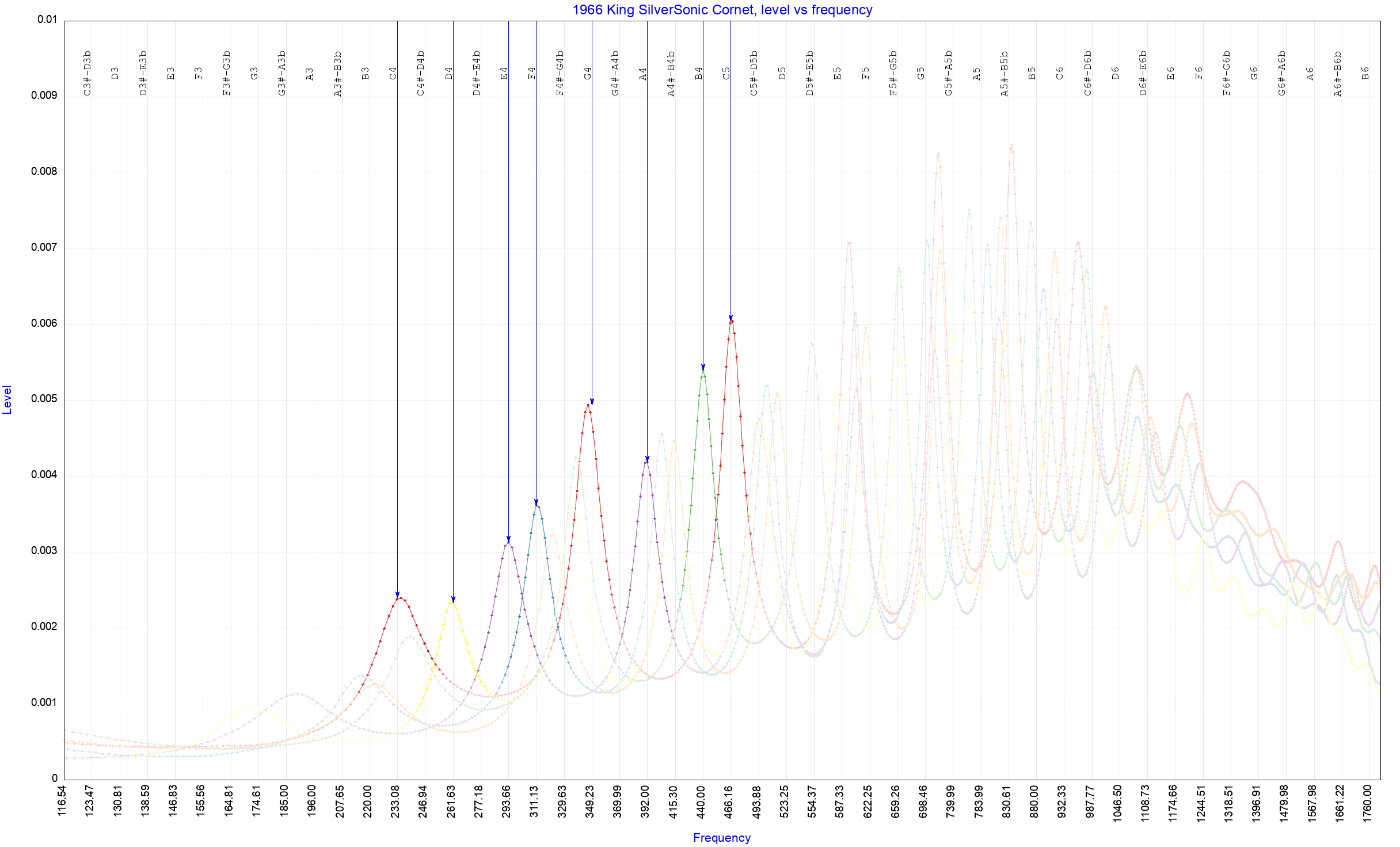| View previous topic :: View next topic |
| Author |
Message |
adms
Regular Member
Joined: 18 May 2021
Posts: 25
Location: Michigan
|
 Posted: Wed Sep 08, 2021 6:42 am Post subject: Bell effect and flat lower register Posted: Wed Sep 08, 2021 6:42 am Post subject: Bell effect and flat lower register |
 |
|
As a trumpet design rather than performance question, does anyone have any experience or done any experiments with the bell effect to adjust the flatness of the low register? (See http://hyperphysics.phy-astr.gsu.edu/hbase/Music/brassa.html for more about the bell effect).
I built a plastic bell that sounds good second-space A and above, but awful in the low register up to G. It's possible this is due to the material, but the resonance of the plastic (how stiff, etc.) should affect *timbre* not whether the note is flat or sharp. In other words, the plastic might eliminate the overtones, but the main note should be in-tune as evidenced by people who put a mouthpiece and a funnel in an appropriate length garden hose and make a reasonable note.
Any ideas why the bell effect wouldn't be working? Any other suggestions for why only the low register is flat (sometimes half a step) while the center of the range sounds decent? (The high range is a little sharp, but passable).
I've racked my brain trying to figure out what's going on acoustically, but running out of ideas.
Thanks for any brainstorms,
Adam |
|
| Back to top |
|
 |
JayKosta
Heavyweight Member

Joined: 24 Dec 2018
Posts: 3297
Location: Endwell NY USA
|
 Posted: Wed Sep 08, 2021 7:13 am Post subject: Posted: Wed Sep 08, 2021 7:13 am Post subject: |
 |
|
What is the construction of the rest of the instrument?
Is the plastic bell being use on a 'tuning bell' (or removable bell) trumpet.
Is the taper rate and size of the plastic bell similar to a conventional trumpet bell? And what is the total length of the plastic bell section?
_________________
Most Important Note ? - the next one !
KNOW (see) what the next note is BEFORE you have to play it.
PLAY the next note 'on time' and 'in rhythm'.
Oh ya, watch the conductor - they set what is 'on time'. |
|
| Back to top |
|
 |
adms
Regular Member
Joined: 18 May 2021
Posts: 25
Location: Michigan
|
 Posted: Wed Sep 08, 2021 7:22 am Post subject: Posted: Wed Sep 08, 2021 7:22 am Post subject: |
 |
|
| The instrument is brass. The plastic bell adds an additional wrap to a standard trumpet bell to shorten the instrument while maintaining the overall tubing length. I shortened the mouthpipe as well, and this material was added to the length of plastic bell. Overall length is of combined tubing is 54". Plastic bell accounts for about 25" of the total. I also have a plastic 3rd slide that bends backwards. Taper rate should very closely simulate the brass bell that was removed.[/img] |
|
| Back to top |
|
 |
Tpt_Guy
Heavyweight Member
Joined: 16 Jul 2004
Posts: 1101
Location: Sacramento, Ca
|
 Posted: Wed Sep 08, 2021 7:47 am Post subject: Posted: Wed Sep 08, 2021 7:47 am Post subject: |
 |
|
Are there any air leaks?
_________________
-Tom Hall-
"A good teacher protects his pupils from his own influence."
-Bruce Lee |
|
| Back to top |
|
 |
adms
Regular Member
Joined: 18 May 2021
Posts: 25
Location: Michigan
|
 Posted: Wed Sep 08, 2021 8:02 am Post subject: Posted: Wed Sep 08, 2021 8:02 am Post subject: |
 |
|
As the 3rd valve and bell are friction fitted in place rather than soldered, leaks are possible, but adding electrical tape to the joints to seal them didn't alleviate the problem.
Right now, middle C is somewhat flat, D thru G is sometimes a quarter tone or more flat, and A and above are OK, or can be at least reasonably lipped in tune. I can *technically* lip the low notes into tune, but only with substantial effort.
Does anyone know if some non-linear acoustics means that plastic parts should be shorter than brass ones for the same resonant frequency? Are ptrumpets and tromba plastic trumpets 54" or something else?
Thanks,
Adam |
|
| Back to top |
|
 |
adms
Regular Member
Joined: 18 May 2021
Posts: 25
Location: Michigan
|
 Posted: Wed Sep 08, 2021 10:38 am Post subject: Posted: Wed Sep 08, 2021 10:38 am Post subject: |
 |
|
| Does anyone know of a simple spectrum analyzer application that I could use to compare the harmonics of the plastic bell to the metal one? |
|
| Back to top |
|
 |
JayKosta
Heavyweight Member

Joined: 24 Dec 2018
Posts: 3297
Location: Endwell NY USA
|
 Posted: Wed Sep 08, 2021 11:21 am Post subject: Posted: Wed Sep 08, 2021 11:21 am Post subject: |
 |
|
| adms wrote: | | The instrument is brass. The plastic bell adds an additional wrap to a standard trumpet bell to shorten the instrument while maintaining the overall tubing length. I shortened the mouthpipe as well, and this material was added to the length of plastic bell. ... |
-------------------
My guess is that the changes you made to the tapered sections of tubing - the mouthpipe / leadpipe, and how the plastic bell tail meshes with the brass bell - is causing the pitch problems. From your description, it seems the entire tapered section of the brass mouthpipe is now missing. And the taper of the brass bell tail has been altered by the addition of the plastic bell tail.
_________________
Most Important Note ? - the next one !
KNOW (see) what the next note is BEFORE you have to play it.
PLAY the next note 'on time' and 'in rhythm'.
Oh ya, watch the conductor - they set what is 'on time'. |
|
| Back to top |
|
 |
adms
Regular Member
Joined: 18 May 2021
Posts: 25
Location: Michigan
|
 Posted: Wed Sep 08, 2021 12:04 pm Post subject: Posted: Wed Sep 08, 2021 12:04 pm Post subject: |
 |
|
The mouthpipe could be contributing, true, but I would think the mouthpipe would contribute more to the mouthpiece effect, i.e. lowering the pitch of the high harmonics, rather than causing the low frequencies to be flat, which is related to the bell effect.
I can piece the brass parts back onto the horn and do some tests to see.
The taper on the bell is an open question, and a fair one. I did try to mimic the conical angle of the cornet's original bell tail, but adding length to it obviously would alter the taper as the length is now stretched by ~2 inches compared to the original.
With the current plastic bell being 3D printed, and taking about 34 hours per iteration, I was hoping there might be experiments I could do with the current hardware that would point me in the right direction before I printed another bell to test.
So far, if it is the taper, I could make the bell taper match the original and transition to a cylindrical bore for the added length, but the amount of taper is so slight, this is probably very nearly the same shape as the existing bell tail.
As an alternative geometry question, does anyone have a sense of how bends or radiuses in tubing would alter the perceived acoustic length? If you took a 54" wound trumpet and compared it to a straight herald's trumpet, would the lengths be identical or would one be slightly shorter than the other to compensate for how the sound wave travels in a bend?
Thanks,
Adam |
|
| Back to top |
|
 |
Beyond16
Veteran Member
Joined: 07 Jan 2020
Posts: 220
Location: Texas Gulf Coast
|
 Posted: Wed Sep 08, 2021 8:11 pm Post subject: Posted: Wed Sep 08, 2021 8:11 pm Post subject: |
 |
|
| adms wrote: | | As an alternative geometry question, does anyone have a sense of how bends or radiuses in tubing would alter the perceived acoustic length? If you took a 54" wound trumpet and compared it to a straight herald's trumpet, would the lengths be identical or would one be slightly shorter than the other to compensate for how the sound wave travels in a bend?
|
According to this, the effective length becomes frequency dependent because the position of node/anti-node within the bend shift with frequency. |
|
| Back to top |
|
 |
Beyond16
Veteran Member
Joined: 07 Jan 2020
Posts: 220
Location: Texas Gulf Coast
|
 Posted: Wed Sep 08, 2021 8:45 pm Post subject: Posted: Wed Sep 08, 2021 8:45 pm Post subject: |
 |
|
| adms wrote: | | Does anyone know of a simple spectrum analyzer application that I could use to compare the harmonics of the plastic bell to the metal one? |
Audacity has one, but I don't think it's the needed tool. Any steady tone from any musical instrument has combinations of harmonics 1,2,3,... The frequencies are always exact multiples of the fundamental, because that's how a periodic wave breaks down.
A more suitable measurement is that of the acoustic impedance for a range of frequencies. This is something I experimented with, and then mothballed. I hoped to find which horn was most in tune. The problem with using this measurement to find the accuracy of slotting is that it doesn't use a good enough substitute for human lips. I used a small speaker attached to the mouthpiece. I believe the mass difference between the speaker diaphragm and the vibrating part of the lip is large. To get the expected results, I had adjust the frequency scale with both a shift and a scale adjustment. Though close, that still doesn't make it a perfect match to tones produced by real lips.
Here is an example:

 |
|
| Back to top |
|
 |
|